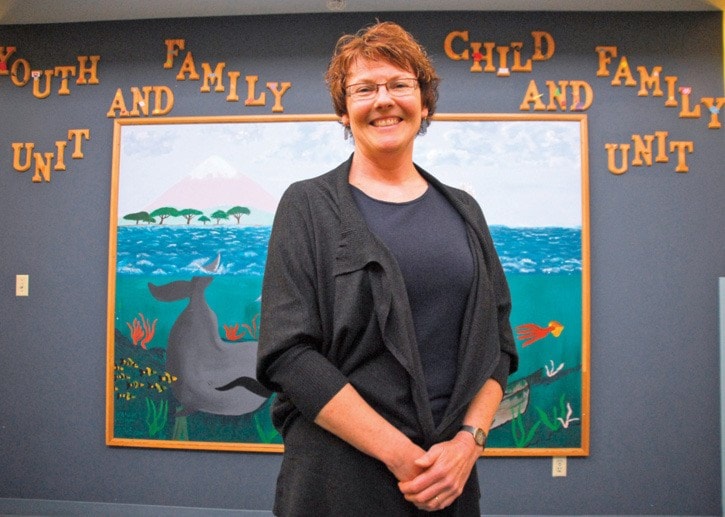The smell of Thai curry wafts through the hallways of Ledger House just before dinner. This is not the norm. Today is a good day for the kids in the intensive care unit at the psychiatric hospital, so the airlock-style doors typically locking them inside are left open.
One teenager cooks the sauce in a small kitchen in the unit, while another simultaneously fumbles with his iPod and plucks away at an acoustic guitar. Both have staff members right at their side watching them carefully, because both are suicidal.
“The kids that come through that unit are there for a variety of reasons. Some are actively suicidal, some are actively psychotic, some are homicidal,” says Elaine Halsall, manager of Ledger.
The two teenagers in the unit have each been there a few months. They live under constant surveillance – cameras and microphones bug their bedrooms, which are nothing but a bed and blank walls – and they aren’t allowed to interact with the other 12 kids who call Ledger home (albeit only temporarily).
The other dozen beds are split between the children’s unit and the youth unit. There, patients can interact with one another, play together, post pictures and drawings on their bedroom walls, and face an onslaught of medical intervention to help them treat and manage their illnesses.
The facility is for kids aged six to 17 who require hospitalized psychiatric care as a result of mental health issues such as trauma, anxiety, complex ADHD or depression.
Ledger serves all of Vancouver Island. Most patients are voluntarily admitted, with the recommendation of a doctor, and the average stay is 32 days.
Its location, on the easternmost shores of Saanich in the picturesque Queenswood neighbourhood, as well as its colourful interior help minimize the appearance of hospitalization.
“Kids shouldn’t be in hospitals,” inpatient co-ordinator Fonda Willis says. “Our location makes it easier to create an environment that’s less like a hospital. The reality is that’s what we are, but we don’t have access to medical facilities like we would if this were a wing at VGH or Royal Jubilee.”
Earlier intervention and better resources province-wide would help minimize the constant demand and wait list for treatment, she says.
“It’s very hard to turn people away. It’s demoralizing,” she says.
For young patients, staff create daily routines to make their lives as comfortable and balanced as they can. And while this is going on, they’re working hard to get the kids stable and reintegrated back into home life.
“Our job is to assess, stabilize and provide intervention so we can help. And we make recommendations to the community, and work with the children’s families to ensure a smooth transition,” Halsall says.
As progress with inpatients is made, the kids are given day passes to leave the hospital to spend time with family and friends out in their own community.
Operated by the Vancouver Island Health Authority, Ledger House is currently going through an internal review after a 16-year-old patient walked away from the facility in December and killed herself.
The teenage girl was “toward the end of her stay,” Willis says, and was a voluntary admission who’d just returned on a day pass.
Saanich police routinely get calls from Ledger House about reports of missing patients. The day the girl went missing, police were contacted on the department’s non-emergency line. No officer was dispatched.
Ninety minutes later, Ledger staff called back informing police the teen had been found dead.
The police department has since undertaken its own an internal review and determined their response was appropriate for the information they had.
In support of the detachment, Willis said: “They did everything we wanted them to do.”
Since then, the response protocol has been clarified so the dialogue between police and Ledger is better informed when a patient is reported missing.
“These changes are good. Everybody benefited from the changes,” Willis says. “This was an extraordinary situation, with many variables involved. But it’s a tragedy we had to lose a child.”
In addition to attending school most days (Ledger has a classroom and teaching staff to help students), patients regularly see a variety of specialists including counsellors, dieticians, occupational therapists, psychiatrists, social workers and speech language pathologists.
“When kids get frightened or confused, they tend to act out and they’re called ‘bad kids.’ But their actions are not usually because they’re bad kids – our job is to figure out why, though,” Willis says. “We keep them here as long as we have to and no longer than they need to.”
Preferably, a facility like Ledger wouldn’t be necessary and resources would be available at an earlier level, in the kids’ communities, to help them manage. But that’s not the reality, Halsall says.
“We’re catching them at the bottom of the waterfall … We need (adequate resources) way upstream.”
kslavin@saanichnews.com
